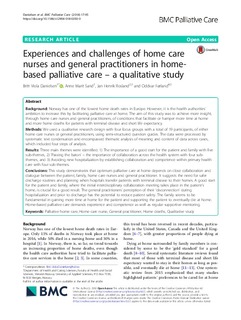| dc.contributor.author | Danielsen, Britt V. | |
| dc.contributor.author | Sand, Anne M. | |
| dc.contributor.author | Rosland, Jan H. | |
| dc.contributor.author | Førland, Oddvar | |
| dc.date.accessioned | 2020-01-29T12:03:58Z | |
| dc.date.available | 2020-01-29T12:03:58Z | |
| dc.date.issued | 2018 | |
| dc.identifier.citation | Danielsen, B.V. et al. (2018): Experiences and challenges of home care nurses and general practitioners in home-based palliative care - a qualitative study. BMC Palliative Care 17, 95. | nb_NO |
| dc.identifier.uri | http://hdl.handle.net/11250/2638588 | |
| dc.description.abstract | Background
Norway has one of the lowest home death rates in Europe. However, it is the health authorities´ ambition to increase this by facilitating palliative care at home. The aim of this study was to achieve more insight, through home care nurses and general practitioners, of conditions that facilitate or hamper more time at home and more home deaths for patients with terminal disease and short life expectancy.
Methods
We used a qualitative research design with four focus groups with a total of 19 participants, of either home care nurses or general practitioners, using semi-structured question guides. The data were processed by systematic text condensation and encompassed thematic analysis of meaning and content of data across cases, which included four steps of analysis.
Results
Three main themes were identified: 1) The importance of a good start for the patient and family with five sub-themes, 2) ‘Passing the baton’ – the importance of collaboration across the health system with four sub-themes, and 3) Avoiding new hospitalization by establishing collaboration and competence within primary health care with four sub-themes.
Conclusions
This study demonstrates that optimum palliative care at home depends on close collaboration and dialogue between the patient, family, home care nurses and general practitioner. It suggests the need for safer discharge routines and planning when hospitals transfer patients with terminal disease to their homes. A good start for the patient and family, where the initial interdisciplinary collaboration meeting takes place in the patient’s home, is crucial for a good result. The general practitioners’ perception of their ‘disconnection’ during hospitalization and prior to discharge has the potential to reduce patient safety. The family seems to be fundamental in gaining more time at home for the patient and supporting the patient to eventually die at home. Home-based palliative care demands experience and competence as well as regular supportive mentoring. | nb_NO |
| dc.publisher | BMC Palliative Care | nb_NO |
| dc.rights | Navngivelse 4.0 Internasjonal | * |
| dc.rights.uri | http://creativecommons.org/licenses/by/4.0/deed.no | * |
| dc.subject | palliative home care | nb_NO |
| dc.subject | home care nurse | nb_NO |
| dc.subject | general practitioner | nb_NO |
| dc.subject | home deaths | nb_NO |
| dc.subject | qualitative study | nb_NO |
| dc.subject | palliasjon | nb_NO |
| dc.subject | palliativ omsorg | nb_NO |
| dc.title | Experiences and challenges of home care nurses and general practitioners in home-based palliative care – a qualitative study | nb_NO |
| dc.type | Journal article | nb_NO |
| dc.source.volume | 17 | nb_NO |
| dc.source.journal | BMC Palliative Care | nb_NO |
| dc.source.issue | 95 | nb_NO |
| dc.identifier.doi | https://doi.org/10.1186/s12904-018-0350-0 | |

